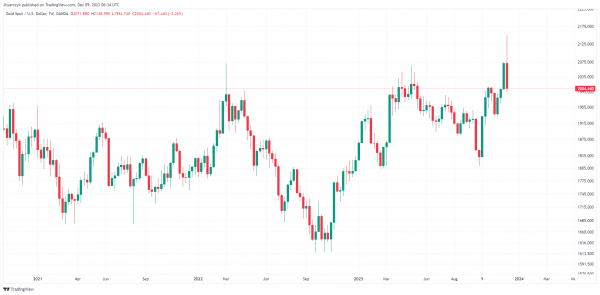Gold Prices Slide Below $2,000 Mark
Last week saw a significant shift in the gold market as prices for XAU/USD retreated below the $2,000 an ounce mark at the close of trading on Friday. The driving forces behind this downturn were noted to be a strengthening U.S. dollar and surging Treasury yields. Traders adjusted their expectations for U.S. interest rate cuts in light of robust jobs data, which caused the price of gold to drop. It’s important to note that the fluctuation in gold prices reflects a complex balance of supply and demand factors, heavily swayed by the broader economic environment and investor sentiment.
The unforeseen strength of the U.S. labor market was a particularly major factor in the week’s gold price movement. The November jobs report showed nonfarm payrolls rising by 199,000 last month, exceeding economists’ predictions. This, along with a decrease in the unemployment rate to 3.7%, indicated a tighter labor market than initially anticipated.
Likewise, geopolitical events and policy decisions also play a pivotal role in shaping gold market trends. Fed Chairman Jerome Powell’s recent remarks suggested that speculations about imminent rate cuts were premature. Meanwhile, the increase in the U.S. dollar index and the recovery of Treasury yields, especially the 10-year note rising to 4.233%, indicate a recalibration of market expectations following the labor market data.
The forthcoming policy meeting of the Federal Reserve on December 12-13 will be critical in shaping the market’s direction. The release of additional economic indicators like consumer inflation data (CPI) will also be important in shaping the short-term forecast for gold prices. With these factors in mind, the gold market is expected to maintain its volatility in the near term, with periods of fluctuating investor sentiment and volatile price swings anticipated. It seems that investors are keenly observing these developments to gauge the potential impact on interest rates and the consequent effects on gold prices.
In conclusion, the gold market is influenced by a variety of factors, from economic indicators to geopolitical events and policy decisions. As the market continues to respond to shifts in the broader economic environment, investors and traders are likely to see volatility and uncertainty in the coming weeks.









